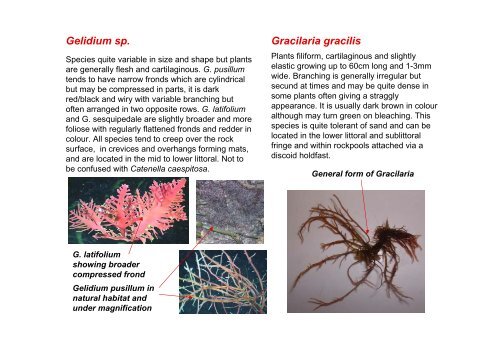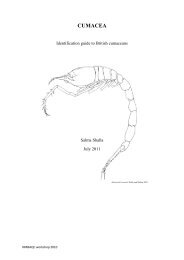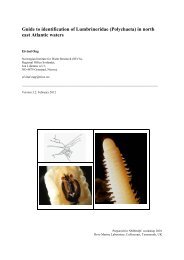s A Field Guide to the British Seaweeds - NMBAQC
s A Field Guide to the British Seaweeds - NMBAQC
s A Field Guide to the British Seaweeds - NMBAQC
You also want an ePaper? Increase the reach of your titles
YUMPU automatically turns print PDFs into web optimized ePapers that Google loves.
Gelidium sp. Gracilaria gracilis<br />
Species quite variable in size and shape but plants<br />
are generally flesh and cartilaginous. G. pusillum<br />
tends <strong>to</strong> have narrow fronds which are cylindrical<br />
but may be compressed in parts, it is dark<br />
red/black and wiry with variable branching but<br />
often arranged in two opposite rows. G. latifolium<br />
and G. sesquipedale are slightly broader and more<br />
foliose with regularly flattened fronds and redder in<br />
colour. All species tend <strong>to</strong> creep over <strong>the</strong> rock<br />
surface, in crevices and overhangs forming mats,<br />
and are located in <strong>the</strong> mid <strong>to</strong> lower lit<strong>to</strong>ral. Not <strong>to</strong><br />
be confused with Catenella caespi<strong>to</strong>sa.<br />
G. latifolium<br />
showing broader<br />
compressed frond<br />
Gelidium pusillum in<br />
natural habitat and<br />
under magnification<br />
Plants filiform, cartilaginous and slightly<br />
elastic growing up <strong>to</strong> 60cm long and 1-3mm<br />
wide. Branching is generally irregular but<br />
secund at times and may be quite dense in<br />
some plants often giving a straggly<br />
appearance. It is usually dark brown in colour<br />
although may turn green on bleaching. This<br />
species is quite <strong>to</strong>lerant of sand and can be<br />
located in <strong>the</strong> lower lit<strong>to</strong>ral and sublit<strong>to</strong>ral<br />
fringe and within rockpools attached via a<br />
discoid holdfast.<br />
General form of Gracilaria




